ACT has developed a lightweight polymer composite radiation shield that enables the use of commercial off-the-shelf (COTS) electronics in space, reducing system cost and accelerating development. The shield provides radiation attenuation and in-plane heat spreading in a thin, conformal structure suited for resource-limited platforms. While COTS devices offer compelling SWaP and performance advantages, they are highly susceptible to the radiation and thermal environments found in orbit. High-energy electrons, trapped radiation belts, solar protons, and cosmic rays can induce TID damage, displacement effects, and functional upsets during long-duration missions.
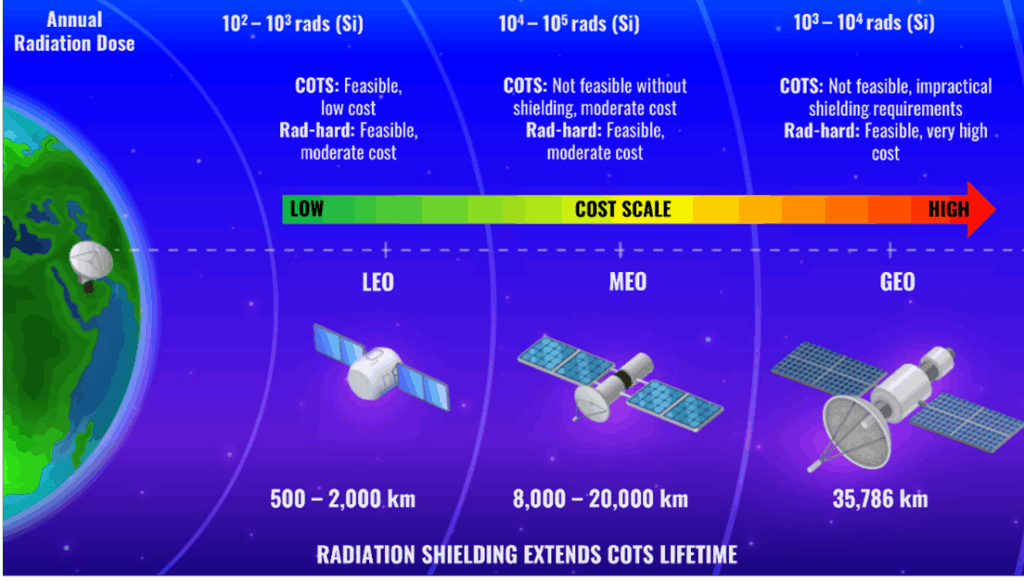
Figure 1. Representative annual radiation dose across common orbital regimes and the relative feasibility of COTS and radiation-hardened electronics.
Radiation-hardened electronics are an alternative, but they are significantly slower than modern COTS processors, have long procurement lead times, and are often prohibitively expensive for small spacecraft programs. As a result, many missions rely on standard electronics combined with external shielding to meet performance and budget requirements. Traditional shielding materials introduce additional constraints. Aluminum provides limited attenuation of energetic electrons and must be thickened to achieve adequate protection, which increases mass and consumes valuable volume around compact electronic assemblies. Dense metals offer higher attenuation but are toxic, inflexible, difficult to integrate, and incompatible with weight-constrained platforms. Conventional metallic housings also do not provide effective in-plane heat spreading, leaving localized hot spots on PCBs that must conduct through the board toward bulky radiators or heat sinks. As missions expand into more challenging environments, such as polar LEO, cislunar transit, and lunar surface operations with large day-night temperature swings, there is a clear need for a lightweight, non-metallic material capable of attenuating radiation, spreading heat, and conformally protecting irregular component geometries without imposing a mass or volume penalty.
A Dual-layer Composite for Radiation and Thermal Management
Dual-layer polymer composites offer an effective way to address both radiation exposure and heat buildup in space electronics. For applications that rely on COTS components, these materials can provide targeted shielding, improved thermal stability, and reduced mass compared with traditional metal enclosures. ACT developed a lightweight composite system that uses two coordinated layers to manage radiation and heat within the same structure. The material can be applied conformally around electronic assemblies and supports spot shielding for high-risk components (Figure 2).
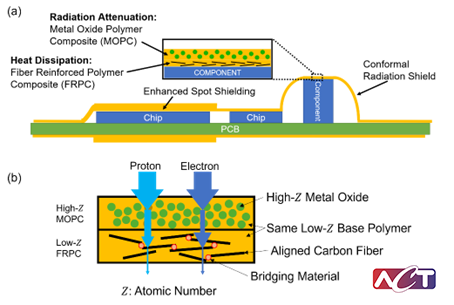
The composite consists of two functional layers:
Metal Oxide Polymer Composite (MOPC)
- A polymer matrix containing a high-atomic-number metal oxide for attenuating energetic electrons and photons.
- Provides higher attenuation per unit mass compared with aluminum
- Flexible and non-metallic to help reduce secondary radiation effects
Fiber Reinforced Polymer Composite (FRPC)
- A thermally conductive polymer composite that spreads heat laterally across the board.
- Demonstrated in-plane thermal conductivity of 3.0 – 3.8 W/m·K
- Reduces localized hot spots on high-power components
Both layers use a compatible polymer base, which maintains cohesive bonding during thermal cycling, vacuum exposure, and mechanical loading. Together, they form a multifunctional shielding system that improves radiation tolerance and thermal performance without adding significant mass or volume
Material Development
The dual-layer composite was developed through targeted refinements to both the radiation attenuation layer and the thermal management layer. The focus of this effort was to improve interfacial cohesion, enhance material uniformity, and ensure stable performance during thermal cycling, vacuum exposure, and radiation environments relevant to space applications.
Metal Oxide Polymer Composite (MOPC)
Initial MOPC formulations used a simple mechanical mixture of polymer and metal oxide particles. Although effective for attenuation, this approach produced weak interfaces and reduced stability under irradiation. To address this, ACT introduced a surface modification process in which the metal oxide particles are coated with a polymer-compatible layer that neutralizes free radicals and improves dispersion (Figure 3). A functional coupling treatment then promotes chemical bonding between the particle surface and the polymer matrix, resulting in a cleaner, more uniform interface.

Fiber Reinforced Polymer Composite (FRPC)
The thermal management layer was designed to provide high in-plane thermal conductivity while remaining electrically insulating and compatible with additive manufacturing. A polymer matrix containing aligned fibers was selected to guide heat laterally across the board (Figure 4). Refinements to the formulation improved fiber dispersion and reduced void formation, resulting in continuous, low-resistance thermal pathways through the composite.
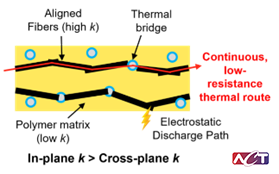
Together, these material developments produced a cohesive, uniform, and environmentally stable dual-layer system suitable for conformal radiation and thermal protection.
Performance evaluation
The dual-layer composite was evaluated through radiation attenuation measurements, environmental testing, thermal characterization, and structural assessments to verify performance for space and planetary missions. These evaluations were designed to confirm shielding effectiveness, demonstrate material stability under space-relevant conditions, and validate the composite as a lightweight alternative to traditional metal shielding.
Radiation Attenuation
Radiation attenuation performance was evaluated using mass attenuation coefficient measurements and annual dose simulations. Figure 5a shows that the metal oxide polymer composite exhibits higher attenuation per unit mass than aluminum across the photon energy range examined, with more than a sevenfold improvement at lower energies where electron-induced bremsstrahlung and trapped radiation dominate in LEO and cislunar environments. Dose modeling (Figure 5b) demonstrates the resulting reduction in annual accumulated dose for a silicon target as shielding mass increases. For equal shield weight, the composite reduces dose more effectively than aluminum, providing additional margin for COTS electronics or enabling thinner, lighter shielding for mass-constrained spacecraft.
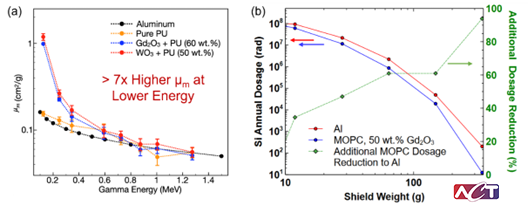
Figure 5. (a) Measured mass attenuation coefficients for polymer composites containing high-Z metal oxides compared with aluminum and pure polymer. The composite exhibits more than seven times higher attenuation per unit mass at lower photon energies. (b) Simulated annual dose to a silicon target as a function of shield weight, comparing aluminum and the metal oxide polymer composite. The composite achieves greater dose reduction at the same mass, increasing radiation protection efficiency for lightweight applications.
These results indicate that the composite offers improved dose reduction per unit mass and is well-suited for electron-dominated radiation environments where aluminum shielding becomes inefficient.
Total Ionizing Dose (TID) Exposure
Material stability under ionizing radiation was evaluated using gamma exposure at total doses of 200, 400, and 600 krad. Six samples were tested at each dose level to ensure statistical relevance. Figure 6a shows the fixture used to position the samples uniformly around the source during irradiation. Following exposure, all samples maintained structural integrity with no visible cracking, embrittlement, or interface degradation. Mechanical testing of irradiated coupons (Figure 6b) showed no significant reduction in tensile strength across the dose range tested. These results indicate that the composite retains its mechanical performance under TID levels representative of multi-year low Earth orbit operations.
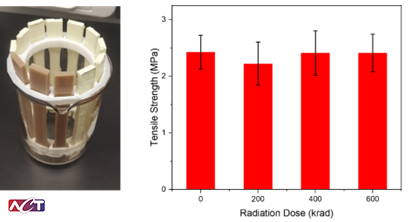
Figure 6. (a) Irradiation test fixture used to arrange composite coupons uniformly around the gamma source during total ionizing dose exposure. (b) Post-irradiation tensile strength for samples exposed to 200, 400, and 600 krad. Six coupons were tested at each dose level, and no significant degradation was observed.
The composite’s stability across 200 – 600 krad demonstrates its suitability for shielding COTS electronics in radiation environments where long-duration exposure can degrade polymer-based materials.
Thermal Performance
Thermal performance of the fiber reinforced polymer composite was evaluated through steady-state conductivity measurements and system-level testing on a Raspberry Pi board. Figure 7a shows the measured in-plane and cross-plane thermal conductivities for molded and printed samples across a range of fiber loadings. In-plane conductivity increased with fiber content and processing method, with the highest formulation achieving values above 3.0 W/m·K. Cross-plane conductivity remained low, preserving electrical insulation and limiting heat transfer into the PCB. A conformal thermal layer was then applied to a Raspberry Pi and evaluated under constant power input. As shown in Figure 7b, the shielded configuration achieved a stabilized junction temperature of 57 °C compared with 64 °C for the unshielded board, demonstrating improved lateral heat spreading and reduced local temperature rise.
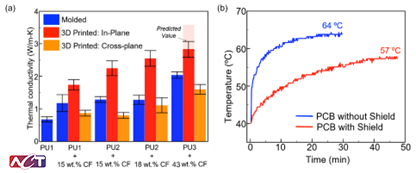
Figure 7. (a) Measured thermal conductivity of molded and 3D-printed composites with varying fiber loadings. In-plane conductivity increases with fiber content and processing method, providing improved lateral heat spreading across the PCB surface. (b) Temperature response of a Raspberry Pi under constant power with and without the thermal composite layer. The shielded configuration stabilizes at a lower temperature, indicating enhanced in-plane heat dissipation.
Enhanced in-plane conductivity and demonstrated reduction in component temperature support the use of the composite as a lightweight thermal management layer in vacuum environments, where convective cooling is unavailable and heat must be redistributed through the board surface.
Thermal Vacuum (TVAC) Testing
Thermal vacuum testing and outgassing evaluations were conducted to assess environmental stability and spacecraft compatibility. Samples, including MOPC dogbones, bilayer MOPC-FRPC blocks, and a fully conformal shielded Raspberry Pi, were cycled between -20 °C and 125 °C under a vacuum of 5 × 10-5 torr. Across more than 400 completed cycles, all samples exhibited repeatable thermal responses with no cracking, delamination, or loss of adhesion, and the dual-layer configuration remained fully bonded throughout (Figure 8). Outgassing measurements were performed separately at -20 °C and 125 °C for 24 hours under the same vacuum conditions. Initial total mass loss values were 0.66 percent for the radiation layer and 0.51 percent for the thermal layer, decreasing to between 0.01 and 0.12 percent after more than 100 thermal cycles. No condensable residues or visible material degradation were observed.

Figure 8. (left) Complete thermal cycling record for shielded and unshielded Raspberry Pi assemblies, bilayer composite blocks, and MOPC dogbones under vacuum (-20 °C to 125 °C). (right) Magnified view of representative thermal cycles showing consistent temperature response and stable performance of the composite materials and shielded electronics throughout testing.
These results confirm that the composite satisfies key environmental durability and contamination control requirements for spacecraft, supporting its use in long-duration orbital and planetary missions.
Weight Reduction Through Spot Shielding
The Selective application of the composite was evaluated as a method to reduce total shielding mass while protecting only the components most sensitive to radiation. Figure 9 compares a conventional full aluminum enclosure with two composite configurations applied to a Raspberry Pi. The aluminum enclosure weighs approximately 153 g and provides uniform shielding over the entire board. In contrast, applying the radiation attenuation layer only over high-risk components reduces total mass to 22 g. A dual-layer configuration, which includes both the radiation and thermal management layers, weighs 45 g. Cross-sectional views reveal that the composite can be placed directly over specific chips while avoiding unnecessary coverage of low-sensitivity areas.
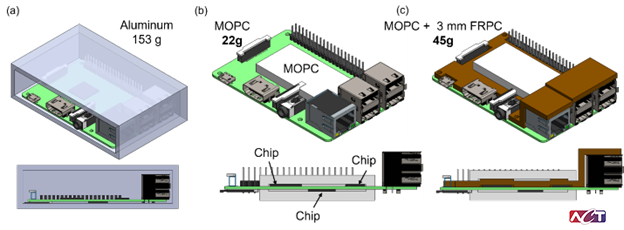
Figure 9. (a) Conventional aluminum enclosure for a Raspberry Pi, weighing 153 g, providing full-board shielding. (b) Selective application of the radiation attenuation layer (MOPC) over sensitive components reduces total mass to 22 g. (c) Dual-layer configuration with radiation and thermal layers (MOPC + FRPC), weighing 45 g, providing targeted shielding and heat spreading.
Spot shielding reduces the total mass by more than 70% compared to a full aluminum enclosure, while maintaining targeted protection for sensitive components. This approach is well suited for small satellites and spacecraft where mass and volume constraints limit the use of conventional metal housing.
The dual-layer composite offers a lightweight and adaptable solution for protecting COTS electronics in radiation- and vacuum-environments. Testing demonstrated improved attenuation compared with aluminum, stable mechanical performance after high-dose irradiation, effective lateral heat spreading, and compliance with space outgassing and thermal cycling requirements. These results indicate that the composite can support component-level shielding in mass-constrained spacecraft and small satellite platforms. Ongoing work focuses on system-level integration and preparing the material for flight demonstration.
Patent Filing
Patent: Filing and servicing of two U.S. patent applications related to the radiation shield technology, with legal support provided by McNees Wallace & Nurick LLC.
- U.S. Patent Application No. 18/882,313 (filed September 2024)
- U.S. Patent Application No. 19/309,108 (filed June 2025)
Technical papers and presentations
- Paper & Presentation: Y. Xiao, A. Zou, D. Carlson, A. Rahman, P. Zhang, “3D-Printed Polymer-Based Conformal Space Radiation Shield with Heat Dissipation”, ICES-2024-468 (53rd International Conference on Environmental Systems, Louisville, KY, July 2024).
- Hanson, Samuel C., Yue Xiao, Ryan Charrette, and Robert B. Hayes. “A preliminary NASA compliant conformal coating for optimized space radiation shielding configurations and its mass attenuation coefficients.” Progress in Nuclear Energy 169 (2024): 105089.
- Presentation only: Y. Xiao, A. Zou, D. Carlson, S. Hanson, A. Rahman, R. Hayes, P. Zhang, “3D-Printed Polymer-Based Conformal Space Radiation Shield with Heat Dissipation”, Small Satellite Conference 2024: Automation – Enabling New Capabilities, Logan, UT, Aug. 2024.
- Presentation only: Y. Xiao, A. Zou, D. Carlson, R. Hayes, P. Zhang, “3D-Printed Polymer-Based Conformal Space Radiation Shield with Heat Dissipation”, 2023 MRS Fall Meeting & Exhibit, Boston, MA, Nov. 2023.
- Presentation: Y. Xiao, A. Zou, S. Khuje, R. Hayes, “3D-Printable Composite for Thermal Dissipation and Radiation Shielding in Space Environments”, Space Thermal Control Workshop (STCW) 2024 and 2025.
- Presentation: Y. Xiao, A. Zou, S. Khuje, R. Hayes, “3D-Printed Polymer-Based Conformal Space Radiation Shield with Heat Dissipation”, Interagency Advanced Power Group (IAPG) 2025.



